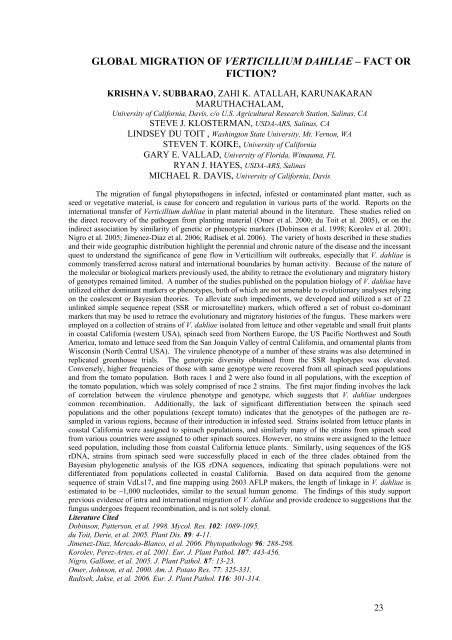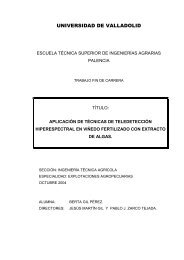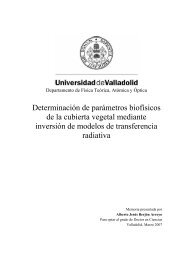10th INTERNATIONAL VERTICILLIUM SYMPOSIUM 16-20 ...
10th INTERNATIONAL VERTICILLIUM SYMPOSIUM 16-20 ...
10th INTERNATIONAL VERTICILLIUM SYMPOSIUM 16-20 ...
You also want an ePaper? Increase the reach of your titles
YUMPU automatically turns print PDFs into web optimized ePapers that Google loves.
GLOBAL MIGRATION OF <strong>VERTICILLIUM</strong> DAHLIAE – FACT ORFICTION?KRISHNA V. SUBBARAO, ZAHI K. ATALLAH, KARUNAKARANMARUTHACHALAM,University of California, Davis, c/o U.S. Agricultural Research Station, Salinas, CASTEVE J. KLOSTERMAN, USDA-ARS, Salinas, CALINDSEY DU TOIT , Washington State University, Mt. Vernon, WASTEVEN T. KOIKE, University of CaliforniaGARY E. VALLAD, University of Florida, Wimauma, FLRYAN J. HAYES, USDA-ARS, SalinasMICHAEL R. DAVIS, University of California, DavisThe migration of fungal phytopathogens in infected, infested or contaminated plant matter, such asseed or vegetative material, is cause for concern and regulation in various parts of the world. Reports on theinternational transfer of Verticillium dahliae in plant material abound in the literature. These studies relied onthe direct recovery of the pathogen from planting material (Omer et al. <strong>20</strong>00; du Toit et al. <strong>20</strong>05), or on theindirect association by similarity of genetic or phenotypic markers (Dobinson et al. 1998; Korolev et al. <strong>20</strong>01;Nigro et al. <strong>20</strong>05; Jimenez-Diaz et al. <strong>20</strong>06; Radisek et al. <strong>20</strong>06). The variety of hosts described in these studiesand their wide geographic distribution highlight the perennial and chronic nature of the disease and the incessantquest to understand the significance of gene flow in Verticillium wilt outbreaks, especially that V. dahliae iscommonly transferred across natural and international boundaries by human activity. Because of the nature ofthe molecular or biological markers previously used, the ability to retrace the evolutionary and migratory historyof genotypes remained limited. A number of the studies published on the population biology of V. dahliae haveutilized either dominant markers or phenotypes, both of which are not amenable to evolutionary analyses relyingon the coalescent or Bayesian theories. To alleviate such impediments, we developed and utilized a set of 22unlinked simple sequence repeat (SSR or microsatellite) markers, which offered a set of robust co-dominantmarkers that may be used to retrace the evolutionary and migratory histories of the fungus. These markers wereemployed on a collection of strains of V. dahliae isolated from lettuce and other vegetable and small fruit plantsin coastal California (western USA), spinach seed from Northern Europe, the US Pacific Northwest and SouthAmerica, tomato and lettuce seed from the San Joaquin Valley of central California, and ornamental plants fromWisconsin (North Central USA). The virulence phenotype of a number of these strains was also determined inreplicated greenhouse trials. The genotypic diversity obtained from the SSR haplotypes was elevated.Conversely, higher frequencies of those with same genotype were recovered from all spinach seed populationsand from the tomato population. Both races 1 and 2 were also found in all populations, with the exception ofthe tomato population, which was solely comprised of race 2 strains. The first major finding involves the lackof correlation between the virulence phenotype and genotype, which suggests that V. dahliae undergoescommon recombination. Additionally, the lack of significant differentiation between the spinach seedpopulations and the other populations (except tomato) indicates that the genotypes of the pathogen are resampledin various regions, because of their introduction in infested seed. Strains isolated from lettuce plants incoastal California were assigned to spinach populations, and similarly many of the strains from spinach seedfrom various countries were assigned to other spinach sources. However, no strains were assigned to the lettuceseed population, including those from coastal California lettuce plants. Similarly, using sequences of the IGSrDNA, strains from spinach seed were successfully placed in each of the three clades obtained from theBayesian phylogenetic analysis of the IGS rDNA sequences, indicating that spinach populations were notdifferentiated from populations collected in coastal California. Based on data acquired from the genomesequence of strain VdLs17, and fine mapping using 2603 AFLP makers, the length of linkage in V. dahliae isestimated to be ~1,000 nucleotides, similar to the sexual human genome. The findings of this study supportprevious evidence of intra and international migration of V. dahliae and provide credence to suggestions that thefungus undergoes frequent recombination, and is not solely clonal.Literature CitedDobinson, Patterson, et al. 1998. Mycol. Res. 102: 1089-1095.du Toit, Derie, et al. <strong>20</strong>05. Plant Dis. 89: 4-11.Jimenez-Diaz, Mercado-Blanco, et al. <strong>20</strong>06. Phytopathology 96: 288-298.Korolev, Perez-Artes, et al. <strong>20</strong>01. Eur. J. Plant Pathol. 107: 443-456.Nigro, Gallone, et al. <strong>20</strong>05. J. Plant Pathol. 87: 13-23.Omer, Johnson, et al. <strong>20</strong>00. Am. J. Potato Res. 77: 325-331.Radisek, Jakse, et al. <strong>20</strong>06. Eur. J. Plant Pathol. 1<strong>16</strong>: 301-314.23




